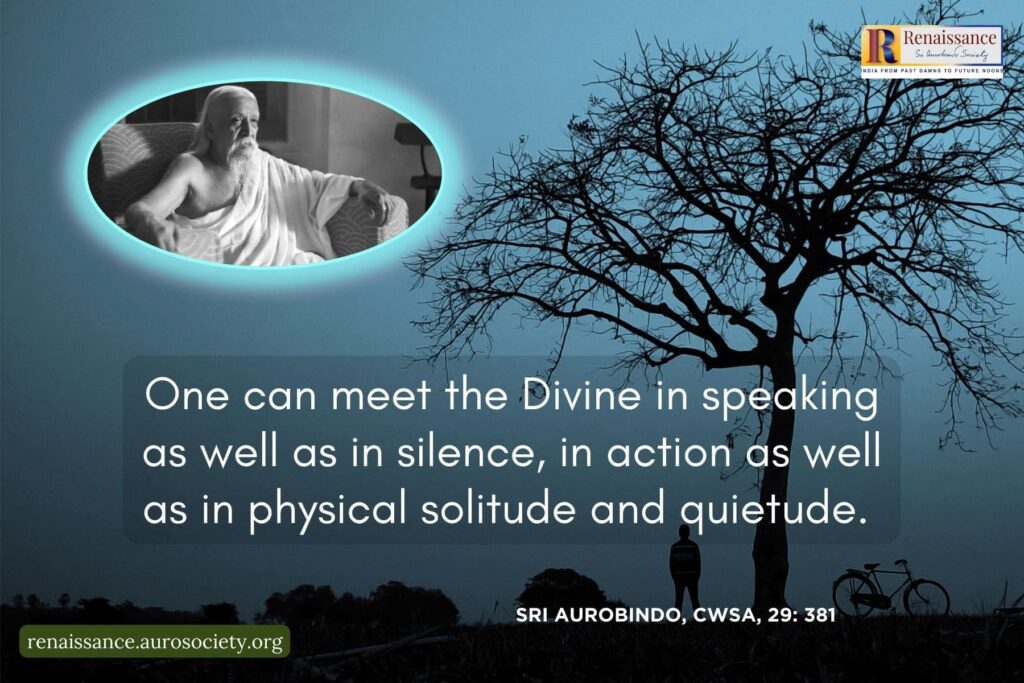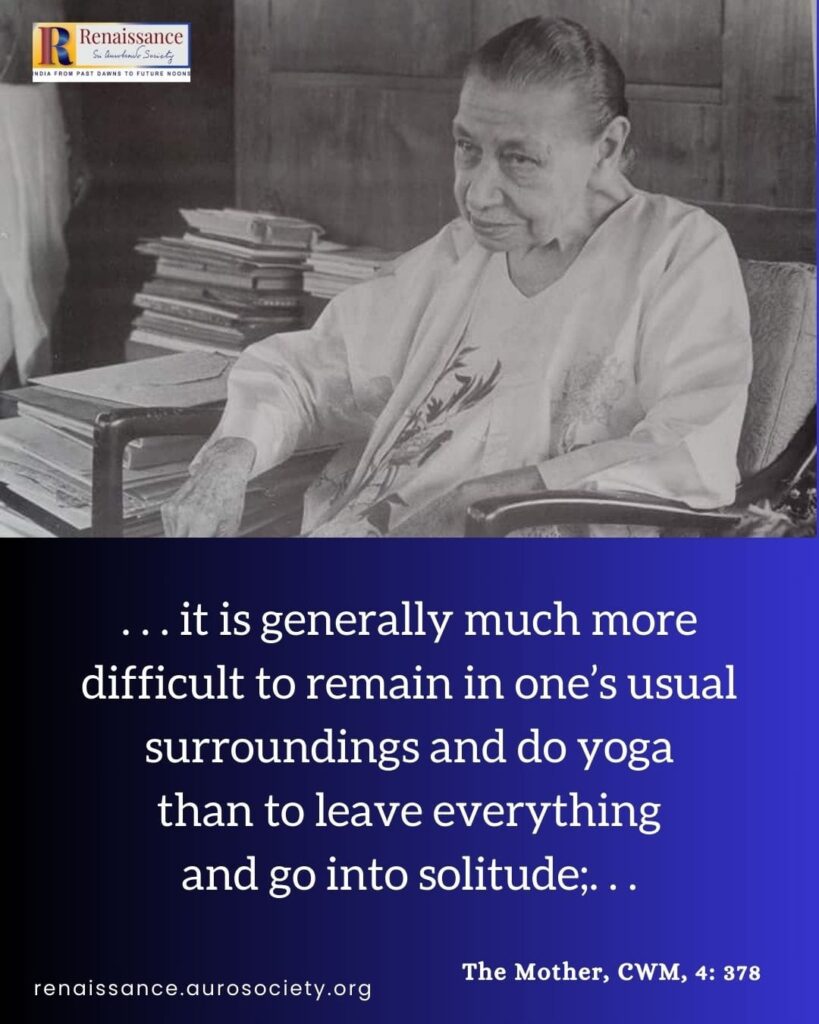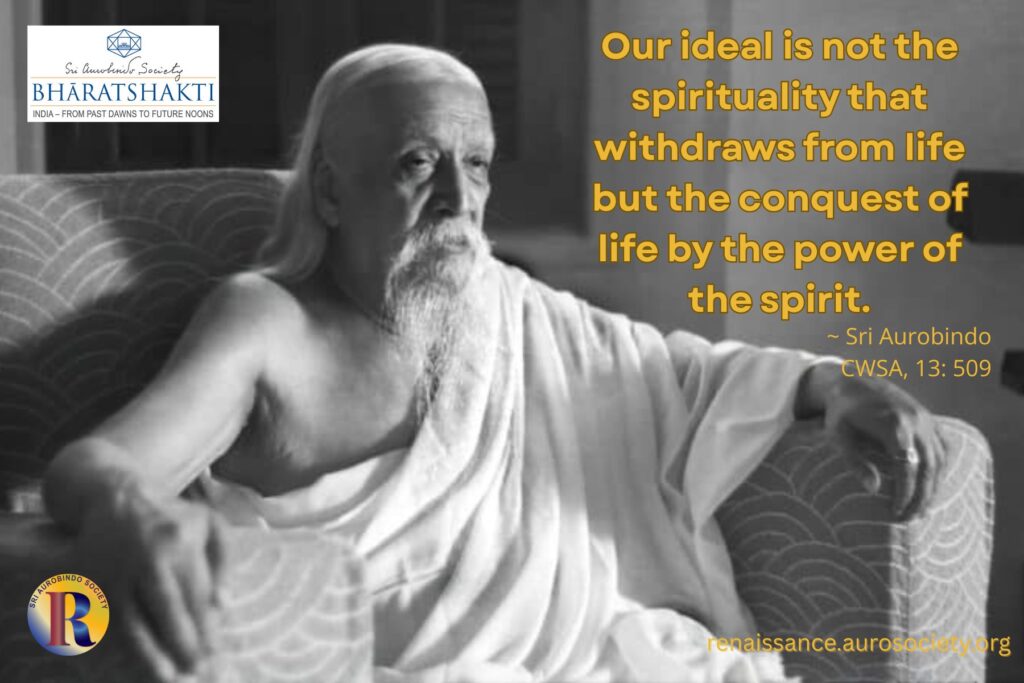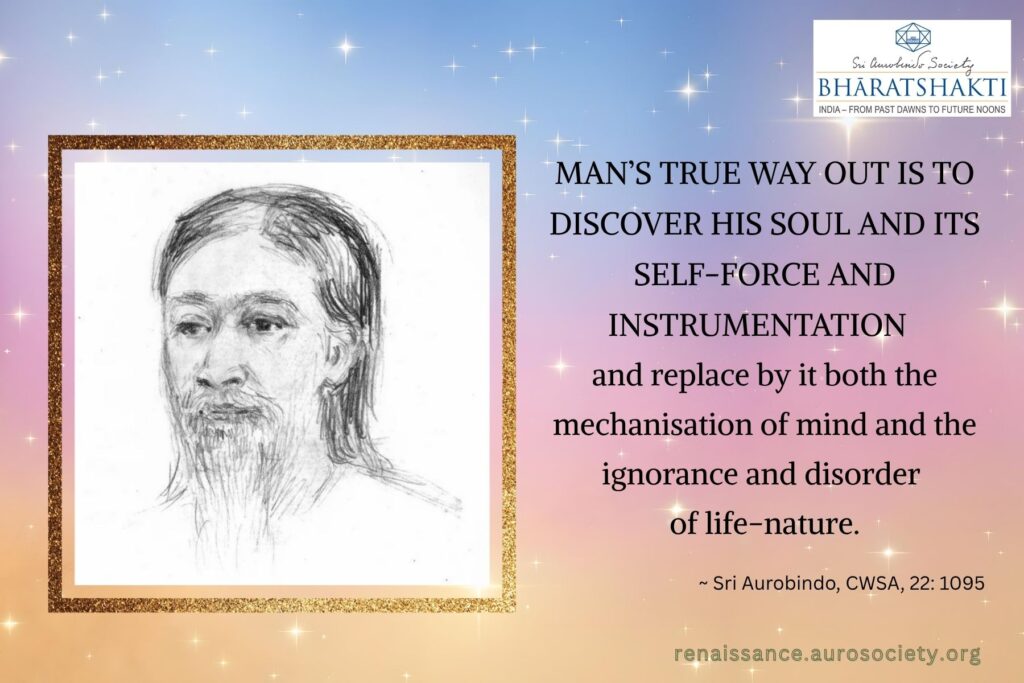Volume V, Issue 6-7
Author: Beloo Mehra
When all life is yoga, how can we not speak of human relationships in the light of yogic wisdom? We must. In fact, we did a whole issue in January 2023 on Human Relations and Yoga. In this second issue exploring Silence and Solitude, we begin with a reflection on the place of solitude in human relations.
Sri Aurobindo reminds in a letter to a disciple,
“…to be capable of solitude and to have the Ananda of solitude can always be helpful to sadhana, and a power of inner solitude is natural to the Yogi.”
~ CWSA, Vol. 31, p. 339

Just as in sadhana, in human relations also, one must be able to enjoy some inner solitude. It is there one must first discover and feel a sense of wholeness, because that will prepare one for having a meaningful relation with the other. As has been said by many, a fulfilling relationship also needs space in between.
When the modern rationalistic mindset, once super happy and content with its strong dose of individualism and ‘my life, my choice’ finds that extreme to be unhealthy, the pendulum swings to the other extreme. And we begin to see way too much emphasis on companionship, spending quality time together, doing things together, etc. But what is generally ignored is the need to have enough spaces in companionship…on the value of creating healthy inner solitude while still enjoying a beautiful relationship.
It was thoughts like these which led me to pen down a few lines some time back.
Solitude – A Meditation
She wished she knew that Life isn’t
What others say
Or what her head or heart say it is,
But Life simply is.
She wished she knew that Love isn’t
What others say
Or what her head or heart say it is,
But Love simply is.
She wished she knew that Life and Love
Are not ‘out’ there but blossom ‘in’ here.
That only in a deep inner solitude
Love becomes Life, and Life Love.
She wished she knew then what she knew now.
She would have loved, lived, and lived love.
But she will, now.
In solitude. In Love.
This 100-word meditation was inspired by one of my favourite poems from the voluminous writings of Amrita Pritam, a prominent name in the world of Punjabi literature and recipient of the 1956 Sahitya Akademi Award. I find her juxtaposition of companionship and solitude so enticing and so true. I have read majority of her works in Hindi, and a few in English translation.
The particular passage which inspired the above lines goes like this:
जिसके साथ होकर भी तुम अकेले रह सको,
वही साथ करने योग्य है।
जिसके साथ होकर भी तुम्हारा अकेलापन दूषित न हो,
तुम्हारी तन्हाई तुम्हारा एकांत बना रहे।
जो अकारण तुम्हारी तन्हाई में प्रवेश न करे।
जो तुम्हारी सीमाओं का आदर करे।
जो तुम्हारे एकांत पर आक्रामक न हो।
तुम बुलाओ तो पास आये।
इतना ही पास आये जितना तुम बुलाओ,
और जब तुम अपने भीतर उतर जाओ तो तुम्हे अकेला छोड़ दे।
I can try translating it for non-Hindi-knowing readers, but that would take away the beauty of her words. Instead it maybe better to share a somewhat similar thought from an American writer, bell hooks.
“Knowing how to be solitary is central to the art of loving. When we can be alone, we can be with others without using them as a means of escape.”
Not exactly the same thought, but still close. Perhaps different cultural perspectives. One speaks of solitude in love that is necessary for the sake of solitude itself, the other for the sake of becoming better at loving. Same difference? Let the reader ponder.
But what is common in both these ideas is the emphasis on a healthy understanding of solitude, its rightful and necessary place in life, its value for developing a strong inner life, and its value for having meaningful and fulfilling relationships with others. Amrita Pritam emphasizes that a true companion will never take away your solitude, will gently retreat when he/she sees that you are now entering your inner quiet and solitary space. Bell hooks delicately cautions that if we don’t know how to retreat within our inner solitude and feel our wholeness there, we could get clingy and needy in our relationships with others.

In this issue
In the previous issue we featured a few letters of Sri Aurobindo where he discusses the desirability of limiting social contacts but without going into an absolute isolation or retirement. In the current issue we feature a few passages from the Mother’s works to deepen our understanding of this. The feature titled On Controlling One’s Subconscient and Yoga in the World highlight the life-affirming aspect of Integral Yoga, and reminds us that this is not the path of ascetic doing sadhana in solitude, but one that is done in the world with all challenges that life presents.
To Talk or Not to Talk features selected letters of Sri Aurobindo which help us understand the value of controlling our urge to indulge in unnecessary talking, especially if we aspire to walk on the path of sadhana. He reminds us that talking often leads to a dispersion of consciousness. But he also emphasizes that instead of observing complete mauna, we must become conscious of our speech, learn to control it, and also practice keeping an inner detached state when speaking. We also include a narration of Kahlil Gibran’s poem titled ‘On Talking‘.
The 2-part feature titled Control of Speech, Mental Austerity and Inner Silence helps us deepen our understanding of the need to control our speech instead of complete abstinence as it highlights the relevant selection from the Mother’s essay titled ‘The Four Austerities and the Four Liberations‘. Through several practical examples, she helps us understand how we can consciously practice this control of speech in order to progress on the path of Integral development.
Silence and Solitude Theme – Part 1
The True Solitude is an Inner Separation highlights two short commentaries by M.P. Pandit from Volume 4 of Commentaries on the Mother’s Ministry. These commentaries give us a comprehensive understanding of the right place and value of solitude in the dynamic Integral quest for progress, perfection and transformation.
We have also included some practical guidance from the Mother with regard to Silence and Education. In One Note of Zen, Narendra Murty tells the story of a Zen master, Kakua, the first Japanese to study Zen. But no one remembers Kakua. Why? Read on to find the reason. Dimple Chhabra writes a poem in Hindi titled, चल, आज कहीं चुपचाप जा बैठें – Come, Let’s Go to That Quiet Place which speaks of the aspirant’s yearning for that Silence and Solitude in which she can constantly stay connected with the Divine.
As always, we offer this work at the lotus feet of Sri Aurobindo and the Mother.
In gratitude,
Beloo Mehra (for Renaissance Editorial Team)



